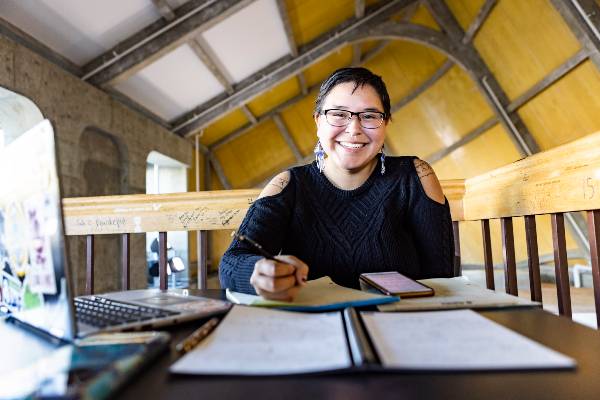Caitlynn Hanna

A sawed-off 6-foot bow section of a concrete canoe stands upright in a Duckering Building hall, part of a display about engineering at 51ЈзЅчєўЌш. Look closely, and youвАЩll see a subtle image of a harpoon pressed into the boatвАЩs floor.
ItвАЩs a detail that reveals much about Caitlynn Hanna, a civil engineering graduate who helped design and build the canoe.
Hanna grew up mostly in Anchorage, but both her grandmothers are I√±upiat from the Kotzebue region. There, people traditionally use harpoons to hunt seals from boats called umiaqs. So Hanna, as a member of 51ЈзЅчєўЌшвАЩs concrete canoe team, suggested the umiaq theme for the 2020 competition.
That was HannaвАЩs second year on the team. She started as a freshman in 2019, when the team placed third overall and first in racing at the national competition.
Preparing for the racing part of the competition posed an extra challenge because of the below-freezing conditions in winter.
вАЬThereвАЩs never any open water, so we can never really practice with our canoe,вАЭ Hanna noted. Instead, they used a plastic canoe late at night in the universityвАЩs swimming pool. The tight quarters created additional challenges.
вАЬOur claim to fame is that weвАЩre really good at turning because we practice in the Patty pool,вАЭ she said.
Unfortunately, the COVID-19 pandemic canceled the 2020-2022 yearвАЩs in-person events,
so the 2019 competition was the only one Hanna was able to join in-person before earning
her engineering degree.
Rural connections
Engineering was a natural choice for Hanna, who excelled in math after some early tutoring in elementary school.
In high school, she took advanced placement calculus. She also joined the Alaska Native Science and Engineering ProgramвАЩs summer math program for high school students.
Once at 51ЈзЅчєўЌш, she continued to focus on math and ended up one class away from a minor when she graduated.
Instead of math, though, she decided to earn a minor in rural development. That also was a natural choice, given her I√±upiaq roots and connections to AlaskaвАЩs remote villages. Her I√±upiaq name is Tautuk.
As a child growing up in Anchorage, she would spend summers outside Nome. Her family
has a camp on the nearby Niaqluk River. HannaвАЩs mother would take her there each summer
to fish for silver salmon and pick berries.
A real canoe
Despite the pandemic-imposed limitations on the concrete canoe competitions, Hanna said, the 51ЈзЅчєўЌш team took pride in their work.
вАЬA lot of teams do a U-shaped hull because itвАЩs easy to fabricate,вАЭ she said. вАЬWe wanted to do an actual real shape for the hull.вАЭ
So 51ЈзЅчєўЌшвАЩs canoes have featured a вАЬtumblehomeвАЭ design вАФ a curved side that allows canoeists to hold their paddles more vertically without bashing their knuckles on gunwales. The shape, while common in certain types of real canoes, has less secondary stability, so practice is necessary.
вАЬOne team tried to do a tumblehome, and during the race they actually tipped over because it was new to them,вАЭ Hanna said.
Before coming to 51ЈзЅчєўЌш, Hanna also applied to big colleges in the Pacific Northwest вАФ colleges that 51ЈзЅчєўЌш faces annually in the concrete canoe competition. But sheвАЩs glad she chose 51ЈзЅчєўЌш.
вАЬI got to be involved as a freshman, whereas at all these very big colleges, itвАЩs very competitive to get on the team or even participate,вАЭ she said.


